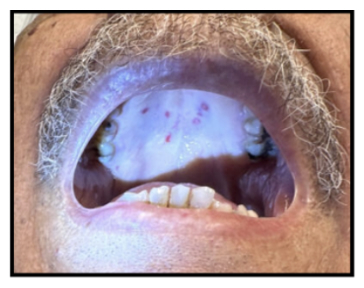Sunday Poster Session
Category: GI Bleeding
P1014 - Hereditary Hemorrhagic Telangiectasia Diagnosed in Late Adulthood: The Role of Diagnostic Vigilance and Intergenerational Implications
Sunday, October 26, 2025
3:30 PM - 7:00 PM PDT
Location: Exhibit Hall

Akira Folk, DO (she/her/hers)
Banner - University of Arizona Tucson
Tucson, AZ
Presenting Author(s)
Akira Folk, DO1, Rama Mouhaffel, MD2, Dallin M.. Ollerton, MD1, Malini Chauhan, MD1, Cameron Thompson, MD1
1Banner - University of Arizona Tucson, Tucson, AZ; 2Banner - University of Arizona Tucson, Tuscon, AZ
Introduction: Hereditary hemorrhagic telangiectasia (HHT) is a rare autosomal dominant vascular disorder characterized by mucocutaneous telangiectasias and arteriovenous malformations (AVMs) in multiple organs. Although typically diagnosed in younger patients, delayed recognition in older adults presents unique clinical and intergenerational challenges.
Case Description/
Methods: We report a case of a 72-year-old Spanish-speaking male with lifelong recurrent epistaxis, iron deficiency anemia, and gastrointestinal (GI) bleeding due to AVMs, who was hospitalized for melena. Endoscopy revealed AVMs throughout the upper GI tract, including the gastroesophageal junction, stomach, and duodenum (Figure 1A–C). These lesions were successfully treated with argon plasma coagulation and clips. Despite multiple prior endoscopic and video capsule evaluations across various institutions, no unifying diagnosis had been made.
A focused history uncovered a cerebral AVM surgically clipped in the 1980s and a maternal history of recurrent epistaxis, raising suspicion for HHT. Physical examination demonstrated telangiectasias in the oral cavity (Figure 2), and the patient met the Curaçao Criteria for clinical diagnosis. Genetic testing identified a pathogenic variant in the activin A receptor type II-like 1 (ACVRL1) gene, consistent with HHT type 2. Notably, subsequent family screening revealed a large cerebral AVM in his daughter requiring surgical resection to prevent a potentially fatal hemorrhage.
Discussion: HHT type 2 is commonly associated with hepatic AVMs and a lower prevalence of pulmonary and cerebral AVMs compared to HHT type 1. However, patients with ACVRL1 mutations may still develop life-threatening AVMs in the lungs or brain, as seen in this family. ACVRL1 mutations impair the function of activin receptor-like kinase 1 (ALK1), a type I receptor in the transforming growth factor-beta superfamily critical for vascular development and endothelial signaling.
This case highlights the critical role of gastroenterologists in identifying HHT through endoscopic recognition of GI AVMs and emphasizes the importance of diagnostic vigilance in patients with unexplained bleeding. Early diagnosis enables timely intervention and cascade genetic screening, reducing morbidity and mortality among affected family members. Increased awareness and thorough evaluation are vital for improving outcomes across generations.

Figure: Figure 1. Endoscopic images demonstrating arteriovenous malformations located at the gastroesophageal junction (A), the body of the stomach (B), and the duodenum (C). These vascular lesions, along with additional sites, were identified as sources of gastrointestinal bleeding and successfully treated with argon plasma coagulation and clips.

Figure: Figure 2. Mucosal telangiectasias visualized on the hard palate.
Disclosures:
Akira Folk indicated no relevant financial relationships.
Rama Mouhaffel indicated no relevant financial relationships.
Dallin Ollerton indicated no relevant financial relationships.
Malini Chauhan indicated no relevant financial relationships.
Cameron Thompson indicated no relevant financial relationships.
Akira Folk, DO1, Rama Mouhaffel, MD2, Dallin M.. Ollerton, MD1, Malini Chauhan, MD1, Cameron Thompson, MD1. P1014 - Hereditary Hemorrhagic Telangiectasia Diagnosed in Late Adulthood: The Role of Diagnostic Vigilance and Intergenerational Implications, ACG 2025 Annual Scientific Meeting Abstracts. Phoenix, AZ: American College of Gastroenterology.
1Banner - University of Arizona Tucson, Tucson, AZ; 2Banner - University of Arizona Tucson, Tuscon, AZ
Introduction: Hereditary hemorrhagic telangiectasia (HHT) is a rare autosomal dominant vascular disorder characterized by mucocutaneous telangiectasias and arteriovenous malformations (AVMs) in multiple organs. Although typically diagnosed in younger patients, delayed recognition in older adults presents unique clinical and intergenerational challenges.
Case Description/
Methods: We report a case of a 72-year-old Spanish-speaking male with lifelong recurrent epistaxis, iron deficiency anemia, and gastrointestinal (GI) bleeding due to AVMs, who was hospitalized for melena. Endoscopy revealed AVMs throughout the upper GI tract, including the gastroesophageal junction, stomach, and duodenum (Figure 1A–C). These lesions were successfully treated with argon plasma coagulation and clips. Despite multiple prior endoscopic and video capsule evaluations across various institutions, no unifying diagnosis had been made.
A focused history uncovered a cerebral AVM surgically clipped in the 1980s and a maternal history of recurrent epistaxis, raising suspicion for HHT. Physical examination demonstrated telangiectasias in the oral cavity (Figure 2), and the patient met the Curaçao Criteria for clinical diagnosis. Genetic testing identified a pathogenic variant in the activin A receptor type II-like 1 (ACVRL1) gene, consistent with HHT type 2. Notably, subsequent family screening revealed a large cerebral AVM in his daughter requiring surgical resection to prevent a potentially fatal hemorrhage.
Discussion: HHT type 2 is commonly associated with hepatic AVMs and a lower prevalence of pulmonary and cerebral AVMs compared to HHT type 1. However, patients with ACVRL1 mutations may still develop life-threatening AVMs in the lungs or brain, as seen in this family. ACVRL1 mutations impair the function of activin receptor-like kinase 1 (ALK1), a type I receptor in the transforming growth factor-beta superfamily critical for vascular development and endothelial signaling.
This case highlights the critical role of gastroenterologists in identifying HHT through endoscopic recognition of GI AVMs and emphasizes the importance of diagnostic vigilance in patients with unexplained bleeding. Early diagnosis enables timely intervention and cascade genetic screening, reducing morbidity and mortality among affected family members. Increased awareness and thorough evaluation are vital for improving outcomes across generations.

Figure: Figure 1. Endoscopic images demonstrating arteriovenous malformations located at the gastroesophageal junction (A), the body of the stomach (B), and the duodenum (C). These vascular lesions, along with additional sites, were identified as sources of gastrointestinal bleeding and successfully treated with argon plasma coagulation and clips.

Figure: Figure 2. Mucosal telangiectasias visualized on the hard palate.
Disclosures:
Akira Folk indicated no relevant financial relationships.
Rama Mouhaffel indicated no relevant financial relationships.
Dallin Ollerton indicated no relevant financial relationships.
Malini Chauhan indicated no relevant financial relationships.
Cameron Thompson indicated no relevant financial relationships.
Akira Folk, DO1, Rama Mouhaffel, MD2, Dallin M.. Ollerton, MD1, Malini Chauhan, MD1, Cameron Thompson, MD1. P1014 - Hereditary Hemorrhagic Telangiectasia Diagnosed in Late Adulthood: The Role of Diagnostic Vigilance and Intergenerational Implications, ACG 2025 Annual Scientific Meeting Abstracts. Phoenix, AZ: American College of Gastroenterology.
